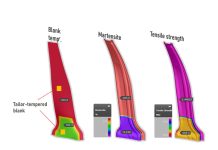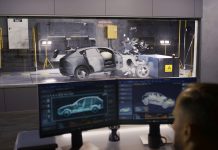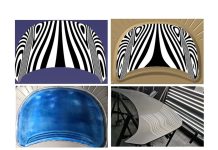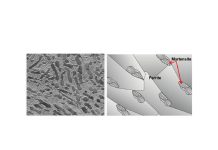Insight Article on Successful Simulation with Material Cards
by Andrew Walker, Technical Product Manager AutoForm
If there were a holy trinity for metal forming simulation work (code excluded), it would be tooling model, process parameters and material definition.

Without good data for all these, one cannot guarantee that the results from the simulation will be anywhere close to the piece of bent metal that is ultimately produced. Yet the truth is, although it is common to reject a simulation study where surfaces are missing from the CAD model (for example), it is all too common for the material card to be considered a ‘no brainer’ or just simply not important enough to expend valuable time and effort over.
Now this would be an acceptable modus operandi, were it not for the large number of incidents of poor simulation results being blamed on the code, when the code is truly the innocent party in this matter. We tend to forget in this modern age that computers and the programs they run are the finest example of GIGO (Garbage In, Garbage Out) that we all know of, yet trust implicitly.
But why do we make these oversights? Particularly when it is so easy to understand what difference the use of good compared to bad material (cards) can make.
It is no different to using good versus bad material at the actual press; the less robust your process, the smaller the process window, the more sensitive it will be to any variation in mechanical properties. The reality is, when you open AutoForm you sit before a virtual press…
As a former user (of FTI, AutoForm, PAM-Stamp, Optris) with almost 25 years of simulation experience, my first port of call when I receive the message of “Your code is @%#!€, The results look nothing like the off tool part!!!” – is the material card, the second would be the friction type and values used. Typically at this point the smoking gun is revealed, the evidence is presented and the case closed. But let’s take a step back.

As the software has evolved since its inception in the mid 90’s, so has the support for material characterization and material card generation. The days of creating text files by hand to describe the material in its most basic form are little more than dim and distant memories, replaced by auto-generated cards using the latest theories and formulae’s.
Part of this development is the continued support of common material testing data and improved processing. An approximation algorithm helps to generate the necessary parameters for the Swift & Hockett-Sherby hardening curve; simply feed the software with raw measurement data (up to x thousand data pairs) available from a simple uniaxial tensile test and voila one hardening curve ready for use. Desire something more advanced? Strain rate dependencies and kinematic hardening are easy to add and set through the use of coefficients.
Whilst in many realms, the importance of the hardening curve is now understood, the yield surface still stands in its shadow as the poor relation. All too often one sees the selection of an inappropriate yield surface model, or (typically due to lack of data) a purely isotropic material. Yet the surface not only marks the boundary between Elastic and Plastic deformation, but how and where the material will ultimately fail. Keep these points in mind next time the springback prediction is light years from the reality or the part splits in an unexpected place.
The FLC has been a mainstay for many years ever since its “discovery” by Goodwin and Keeler. Directly used in the press shop through the use of Circle Grid Analysis, it has the honor of being the most used and least understood facet of a material card. The curve itself has no direct influence on a simulation, it doesn’t change the stresses or strains in the model, indeed one can run a simulation without this curve. Its entire ‘reason d’être’, is purely as a measure of formability, the entire basis of the formability plots upon which many an engineering decision is made. Yet did you know it’s not valid for non-linear strain paths? For bending? For edge cracks? When as a user did you last look at the strain paths in your model before signing off on a multi-million euro tooling project?
At AutoForm we are actively seeking to reverse this trend of the material card being little more than an obscure alphanumeric code full of incomprehensible numbers. AutoForm has the tools to analytically handle data at the highest level, to mimic the real material behavior, yet requiring a minimum of testing capabilities. We aim to provide our users with the widest range of material data direct from the manufacturer as possible. With the recent addition of material cards from MMK, Novelis and SSAB we now offer almost 1,000 material cards direct from the material manufacturers in addition to our generic library. Within this “BrandName” Library the user is provided with a true smorgasbord of materials – Aluminum, Steel, and Stainless Steel from some of Europe’s largest manufacturers.
But we are not resting on our laurels. Soon we will be adding additional material cards from Asian and American material manufacturers. We also offer training on Materials, and material theory specific to forming.
Hopefully, next time you get a set of results that don’t match the off tool, you’ll check the holy trinity before blaming the code or the user……
Note: To assist users in this important selection, AutoForm provides a generic material library as well as almost 1,000 material cards from material manufacturers. What is more, AutoForm offers brand name material data-bases in collaboration with major material suppliers, such as Aperam, ArcelorMittal, Bilstein, Erdemir, MMK, Novelis, Outokumpu, Severstal, SSAB and Tata Steel. Recently updated cards include those from MMK, Novelis and SSAB.
The OEM library is on the AutoForm website HERE.
Andrew Walker’s Bio:
Andrew joined AutoForm in 2016 as a TPM for Materials and Customer Support Engineer for the North of the UK. Prior to this he graduated from the University of York with a degree in Theoretical Physics. Following this he started at a Tier 1 Automotive Supplier based in Coventry. After completion of his Graduate Training Program, he commenced a career in Metal Forming Analysis using FTI, AutoForm and later PAM-Stamp before leaving to join Alcan (now named Novelis.) As part of the support team, he worked in partnership with the Jaguar engineers on the X350 program, from concept to production using AutoForm and Optris codes. In 2011 he moved to Switzerland when the UK office was closed down. Following five years of analysis and material support, he returned to the UK to take up this current position as Technical Product Manager.













